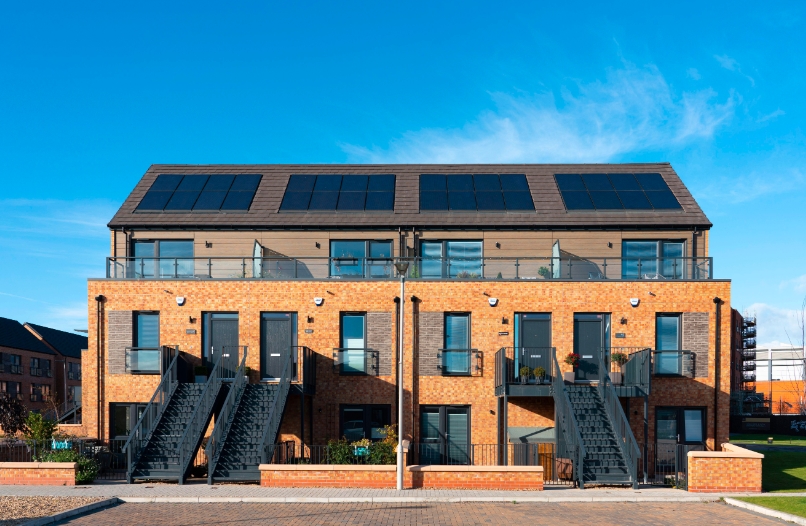Scotland is facing a housing crisis, with a shortage of affordable and energy-efficient homes. The Scottish Government has pledged to build 100,000 new homes by 2032, but how can it ensure that these homes are sustainable and low-carbon? One possible answer is heat pumps, a technology that can provide heating and cooling using renewable energy sources.
What are heat pumps and how do they work?
Heat pumps are devices that transfer heat from one place to another, using electricity or gas as a power source. They can extract heat from the air, water, or ground, and use it to heat or cool buildings, water, or industrial processes. Heat pumps can also work in reverse, by removing heat from a space and transferring it elsewhere.
Heat pumps are more efficient than conventional heating systems, such as boilers or electric heaters, because they use less energy to produce the same amount of heat. For example, a typical air-source heat pump can produce three units of heat for every unit of electricity it consumes, while a gas boiler can only produce one unit of heat for every unit of gas. This means that heat pumps can reduce energy bills and greenhouse gas emissions, while providing comfort and convenience.
Why are heat pumps important for Scotland?
Scotland has a cold and wet climate, which means that heating accounts for a large share of its energy consumption and carbon footprint. According to the Scottish Government, heating and hot water account for 55% of Scotland’s total energy demand, and 36% of its greenhouse gas emissions. Moreover, Scotland has a high proportion of old and poorly insulated homes, which are expensive and difficult to heat.

Heat pumps can help Scotland achieve its ambitious climate targets, which include reducing its greenhouse gas emissions by 75% by 2030, and reaching net zero by 2045. By switching from fossil fuels to heat pumps, Scotland can decarbonize its heating sector and use its abundant renewable energy resources, such as wind, solar, and hydro. Heat pumps can also improve the quality of life and health of Scottish people, by providing clean, comfortable, and affordable heating and cooling.
What are the challenges and opportunities for heat pumps in Scotland?
Despite the potential benefits of heat pumps, their adoption in Scotland has been slow and limited. According to the Scottish Government, only 46,000 heat pumps were installed in Scotland by the end of 2020, out of a total of 2.6 million homes. This is far below the target of 1 million heat pumps by 2030, which the Scottish Government has set as part of its draft Heat in Buildings Strategy.
One of the main barriers to heat pump deployment is the high upfront cost, which can range from £6,000 to £18,000, depending on the type and size of the heat pump. Although heat pumps can save money in the long run, many households and businesses cannot afford the initial investment, especially in the context of the COVID-19 pandemic and economic recession. Another challenge is the lack of awareness and trust among consumers, who may not be familiar with heat pumps or their benefits, or may have concerns about their reliability, performance, or noise.
To overcome these challenges, the Scottish Government has launched several policies and programmes to support and incentivize heat pump installation. These include:
- The Home Energy Scotland Loan, which offers interest-free loans of up to £17,500 for homeowners and landlords to install heat pumps and other energy efficiency measures.
- The Renewable Heat Incentive, which pays households and businesses for the renewable heat they generate from heat pumps and other technologies.
- The Low Carbon Infrastructure Transition Programme, which provides funding and advice for large-scale heat pump projects in the public, private, and community sectors.
- The Heat Networks Bill, which aims to facilitate the development of district heating systems that can use heat pumps and other low-carbon sources.
In addition to these initiatives, the Scottish Government has also announced a £1.6 billion investment over the next five years to transform the energy efficiency and heating of Scotland’s buildings. This includes a £95 million fund to install heat pumps in social housing, and a £50 million fund to support heat pump installation in rural and remote areas. The Scottish Government has also committed to making heat pumps the primary heating technology for new buildings by 2024.
How can heat pumps be part of a major public works programme?
The Scottish Government’s plans to boost heat pump deployment are not only good for the environment, but also for the economy and society. By investing in heat pumps, Scotland can create a major public works programme that can generate jobs, skills, and innovation, while addressing the housing crisis and fuel poverty.
According to a recent report by the Energy Saving Trust, installing 1 million heat pumps in Scotland by 2030 could create up to 16,900 direct and indirect jobs, and add £2.7 billion to the Scottish economy. These jobs would include installers, engineers, manufacturers, suppliers, and trainers, as well as related sectors such as construction, insulation, and renewable energy. The report also estimates that heat pumps could save Scottish households and businesses up to £619 million per year in energy costs, and lift 82,000 households out of fuel poverty.
Furthermore, heat pumps could also stimulate innovation and research in Scotland, by creating demand and opportunities for new and improved technologies, such as hybrid heat pumps, smart controls, and hydrogen-ready heat pumps. Scotland could also become a leader and exporter of heat pump solutions, by sharing its expertise and experience with other countries and regions that are facing similar challenges and opportunities.
Heat pumps are not a silver bullet, but they are a key component of Scotland’s green recovery and energy transition. By embracing heat pumps, Scotland can build a more sustainable, resilient, and prosperous future for its people and the planet.


















